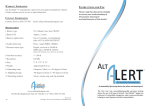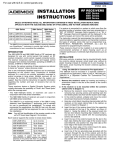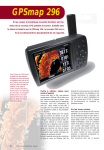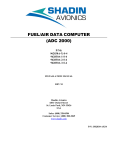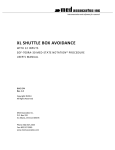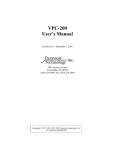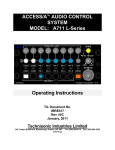Download Installation Manual for AltAlert 3070 Icarus Instruments
Transcript
Installation Manual for AltAlert 3070 Icarus Instruments, Inc. 7000 Carroll Avenue Takoma Park, MD 20912 301-891-0600 Fax 301-89-0666 January 1998 Revision 1.3 1 AltAlert 3070G Installation Manual Introduction The AltAlert 3070 must be installed by an FAA approved avionics facility. The basic connections involve the altitude encoder code lines and an audio output. The optional GPS annunciators and CDI switching signal, if used, require connection to the GPS receiver and CDI switching relay box. The 3070G also optionally provides Mode C altitude data in a serial format for most GPS receivers. This eliminates the need to wire all of the Mode C code lines to both the AltAlert 3070 and the GPS receiver. The 3070 GPS option provides the four annunciators, serial altitude data, and the CDI switching signal to an external relay that is NOT provided. FAA Advisory circulars 43.13-1A and 2A apply to AltAlert concerning installation practices. The AltAlert is totally passive and non-intrusive and is completely isolated from the encoder signals with 100K series resistors on all code lines. No failure of AltAlert can have any affect upon the integrity of the encoder code lines. AltAlert 3070 weighs under a pound and has therefore very little effect upon weight and balance. The power requirements are approximately 100 ma at any voltage from 10 to 30 volts. The power must be protected with a fuse or circuit breaker. The 3070 should be connected to the avionics power bus. AltAlert 3070 consists of a single module that will mount in a standard 2 1/4Ó instrument cutout. The 3070 contains a time-of-day clock powered by an internal lithium battery. The existing aircraft clock may be replaced with the 3070. The 3070 also has an internal approach timer and fuel timer. AltAlert is compatible with all modern encoder/transponder combinations that do not require a pulsed strobe line. As long as the encoder outputs are valid at all times (except warm up), the AltAlert 2 will function properly. If the transponder is a Narco AT-50 or AT-50A, please consult the factory for special procedures. The 3070G has been successfully tested on all modern transponders that do not use a pulsed strobe line. The 3070 has an STC number SA1379GL. A PMA has been issued for the 3070. Harness fabrication The supplied interconnection diagram (Table 1) details the wiring between the 3070 and the existing encoder/transponder and the audio system. The D4 encoder code line (J1/pin 1) is optional and is required only if the encoder can exceed 30,700 feet. The DC input power must be protected with a fuse or circuit breaker. The installer must perform a DC load analysis to determine that the addition of the AltAlert will not overload the power available. Only 100 ma is required for the entire unit. The AltAlert Mode C code line inputs must parallel the existing encoder code line outputs. There is an internal 100K series resistor connected to each encoder input signal to insure complete isolation. The 6200 model will function to 62,700 feet. The D4 line does not have to be connected if the encoder does not have this bit active. One ground signal must connect the AltAlert to the encoder ground. Both the encoder and AltAlert require a pullup voltage supplied by the transponder. The transponder must be on for the altitude functions of the AltAlert to function, otherwise an Eerr (encoder error) will display. The audio output is designed to drive a 500 ohm load with 140 mw available in the loudest position. The loudness can be adjusted in the AUX mode. The audio output should go to an unswitched input on the audio panel if available. The audio output can drive the headphone bus directly although a small series isolation resistor (100 to 470 ohms) may be necessary if the audio is too loud at the lowest setting. Note that there is a separate audio 3 return line (J1/pin 14) that must go to the audio panel's ground. This is a transformer coupled output and this ground return must be used. (The original 3070 did not require this ground to pin 14) There is a separate output for a Sonalert that can be used if there are no audio inputs available on the audio panel. However, there are certain stepped audio tones that are just beeps if the Sonalert is used. It is strongly recommended that the audio output be used instead the Sonalert since many pilots use headphones and the Sonalert tone can be easily lost or confused with other Sonalerts in the aircraft. GPS Signal Connections (Optional) on J2 The GPS connections are shown in Table 2. Note that the 3070 provides Mode C altitude data in a serial format compatible with all Trimble, Garmin, Northstar, and Apollo GPS receivers. If the 3070 is used to provide serial altitude information to the GPS, there is no need to connect the Mode C code lines to the GPS receiver. Annunciators connections The AltAlert has four bright deadfront GPS annunciators labelled MSG, APR, HLD, and WPT. These are wired to the appropriate annunciator outputs on a GPS receiver that has a Message output, Approach output, Hold output, and Waypoint output. The Trimble IFR approved GPS receivers have all these four signals available. Other GPS receivers may not have all of these particular outputs. The internal annunciator lamps are all 28 volt, but 14 volt units are available on special order. Note that pin 13 of J2, the GPS connector is the power source for the GPS annunciators. We recommend that this pin be wired to the arm of a small SPDT switch that has aircraft bus voltage on one side and the dimmer bus on the other side. This day/night switch allows the four 4 annunciators to be dimmed in flight in the night position while providing full intensity in the day position. All GPS receivers have the Waypoint output and some also have one or more of the other annunciator outputs available. The 3070 has the ability to give an alphanumeric alert on the display as well through the audio system when any combination of the four annunciator signals come on. For example, it's important for the pilot to be aware of a waypoint passage when flying an IFR approach. The annunciator lamp combined with the flashing WPT alert and audible alert (beeps) assures that the pilot will not miss the GPS annunciation. To select which of the four annunciator signals will generate a GPS alert with accompanying audio output, see the Special Parameter section at the end of this document. CDI switching signal and GPS/NAV annunciators The 3070 has a pilot switchable output that will drive a CDI relay box such as the NAT RS08 series or equivalent. The CDI mode on the 3070 will toggle the CDI switching signal and cause the CDI relay box to switch the CDI source. The CDI output on the 3070 is a high current open collector transistor. The CDI relay box drives two annunciator lamps located on the lower left of the 3070 labelled GPS and NAV. These annunciators show the pilot which nav source is currently selected. Note that the GPS/NAV annunciators get their 28 volt (or 14 v) DC power from pin 7 on J2. Generally this power comes from the day/night pin of the relay box or the arm of the same SPDT day/night switch mentioned above for the power source for the GPS annunciators. When this switch is in the night position, the dimmer bus will control the intensity of all of annunciators on the face of the 3070 simultaneously. Using a single day/night switch also eliminates the need for a switch for the GPS annunciators and another one for the NAV/GPS source annunciators. 5 The CDI mode can be disabled if the aircraft already has a CDI switch and annunciators. This simply eliminates the CDI Mode to eliminate confusion. See Special Parameter section to disable the CDI mode. Serial Data Output to GPS Receiver The 3070G has a serial data channel for sending Mode C data to the GPS receiver. This channel will drive GPS receivers made by Trimble, Garmin, Northstar, and IIMorrow (Apollo). All of the listed receivers except Apollo use a two wire balanced connection called RS-422. Pin 2 of J2 is TX+ and pin 10 is TX-. These mate with the corresponding RX+ and RX- on the GPS receiverÕs serial port. Apollo uses an RS-232 format. For Apollo receivers connect pin 10 on J2 to the RS-232 Receive Data pin on the receiver and connect pin 5 on J2 to the Apollo's ground pin. To configure the AltAlert 3070's serial output, see Appendix A on Special Parameters at the end of this document. Change parameter Sfmt (Serial Format) to match the receiver model. Note: All IFR approved GPS receivers require the pilot to enter the current barometric pressure into the GPS receiver during the approach phase of a landing. The GPS receiver uses this entry to correct the pressure altitude data from the Mode C encoder to produce actual altitude MSL. Since the 3070G knows the pressure altitude (from the encoder) and the barometric pressure (from the pilot), it can calculate the altitude MSL and supply this corrected altitude to the GPS receiver via the usual serial port. If this corrected mode is selected in the Special Parameters section, the pilot DOES NOT ENTER barometric pressure on the GPS receiver, but simply acknowledges the default 29.92 as the current setting. The GPS receiver uses the corrected data from the 3070 and applies the 29.92 reference which results in no additional correction. This eliminates one additional step in while flying a non-precision GPS approach. 6 If the GPS receiver can support the PABP serial data format, the 3070 will send in both Pressure Altitude and Barometric Pressure. This allows the receiver to compute the altitude and eliminates the need to enter the pressure on the GPS receiver. Trimble TNL 2000 Approach receivers will be able to use this feature in the software release scheduled for spring 1996. Until that release, do not select PABP for the Serial Format. 7 Testing procedures Encoder Interface Be sure that the transponder is on so it can provide a pull up voltage to the code lines. When power is first applied the display will initially say AltAlert X.X and then alternate between the software revision and the display test pattern. Push the small switch in, hold it in, and turn it one click. CLK will display. Use the small knob and large knob to set the local time. Then push and turn the small knob again and BARO (barometric pressure) will appear alternating with 2992. Set in the current barometric pressure using the two knobs. Then push and turn the small knob again and DEST (destination) will appear. When 0.0 shows, push and turn the small switch again until TARG (target) appears. Then use the big knob to set in 2.0 (two thousand feet). Now push and turn the small knob counter clockwise until ALT appears. The display will now show the current altitude plus or minus 100 feet. The display format is thousands of feet to the left of the decimal point and hundreds of feet to the right of the decimal point. If Eerr (encoder error) shows up, it is because the encoder has not yet warmed up and is not yet providing Mode C data. If a strange altitude appears, check the code line wiring. Another cause of the Eerr error is a mixup in the wiring of the "C2 and C4" code lines . If these are mis-wired, illegal gray codes will be detected as the aircraft climbs or descends, causing the the Error message. Most installation problems can be traced to improper wiring of the Mode C code lines. GPS connections To test the annunciators, go into the annunciator test mode on the GPS receiver and illuminate the four GPS annunciators. If some of the annunciators have been configured to provide an audio alert, the audio alert should come on when the annunciator comes on. To test the CDI switching, select CDI Mode and watch the GPS/NAV annunciators toggle. 8 To test the serial altitude connection to the GPS, use the GPS controls to display the altitude from the serial encoder (AltAlert). If the barometric pressure is set to 29.92 on the 3070, the altitude displayed on the GPS should match the altitude displayed on the 3070G in ALT mode. Audio Interface To check audio level, push the small switch in and turn it until AUX appears. Then turn the small switch (not pushed in) until LOUD appears. Then use the big switch to cycle through all the audio levels. Caution, the loudest audio level is very loud, so be careful if you are using a headset. The audio can be set in flight with the engine(s) running to determine the best level. When you have set the audio level, simply push and turn the small switch to store that value. The next time the unit is turned on, that audio level will be used. 9 Appendix A How to Set Special Parameters on AltAlert 3070G The AltAlert 3070 has a number of parameters that need to be set upon installation. These parameters pertain to various AltAlert features that are changed very seldom. Once these parameters are set, they are permanently stored in a battery backed up RAM in the AltAlert. Because these parameters should not be able to be accessed accidentally and inadvertently changed, the process to access and change them involves several steps which is very unlikely to be initiated without intent. Every time AltAlert is powered up, a check is made to be sure that the parameters are all valid values. If there is an error, the display will show SERR. Special Parameters There are six parameters that can be set in the Special Parameter Mode. These are changed very seldom so they are "hidden" behind the E/M parameter. They are: Gear alert message: Gear (GEAR - GUMP - or none) Gear Alert Altitude: Galt (500 to 1000 feet in 100 foot steps above DESTination elevation) Serial Format: Sfmt (Format of the serial altitude data that goes to the GPS receiver: TRIM, NSTR, APLO, and PABP). Reference pressure for serial altitude: Salt (BARC for corrected altitude and BARP for pressure altitude) Applies to TRIM, NSTR, and APLO formats only. BARC setting provides corrected altitude to GPS receiver eliminating need to enter baro pressure into GPS receiver. GPS Alert: Gpsa determines which of the four GPS annunciators will generate a GPS alert. Any combination of the four lines representing 10 Waypoint, Hold, Approach, and Message may be selected. A capital letter means that signal will cause an alert. There are 16 combinations available. CDI switching Mode: Cdi (On to enable CDI Mode, Off to disable) These six parameters are set at GEAR, 1.0 (1000 feet) , TRIM, BARP, Wham, and Off (CDI mode) respectively when the unit is shipped from the factory. Entering Special Parameter Mode Select AUX Mode. Use small switch to select E/M (English/Metric units for BARO Mode) Wait a few seconds until Gear appears. The big switch will select GEAR, GUMP, or OFF for the gear alert. Turn the small switch one CW click and Galt will appear for Gear alert altitude. Use the large switch to select an altitude from 500 to 1000 feet above your destination airport. This displays as 0.5, 0.6, 0.7, 0.8, 0.9 and 1.0. Turn the small switch again one CW click. Sfmt for Serial Format will appear. Use the large switch to select between TRIM, NSTR, APLO, and PABP setting. TRIM selects the Trimble and Garmin format at 9600 baud. NSTR selects the Northstar format at 2400 baud. APLO selects the IIMorrow Apollo format at 1200 baud. PABP is for GPS receivers that can use the pressure altitude and barometric pressure format. Turn the small switch one more click CW and Salt will appear to select the pressure reference for the GPS serial altitude. The large knob will select BARC for barometrically corrected altitude and BARP for pressure altitude (29.92). If BARC is selected, there is no need to set the barometric pressure on the GPS receiver and the AltAlert supplied altitude will automatically be 11 corrected for local barometric pressure as already entered on the 3070G. The Salt setting has no effect if PABP is selected as the format. Turn the small switch one more click and Gpsa (GPS alert) will appear to select which annunciators will generate a signal specific GPS alert when they illuminate. There are sixteen combinations of the four lines representing Waypoint, Hold, Approach, and Message. The default is Wham where the capital W says to generate an alert for the Waypoint signal. As the large knob is turned, additional capital letters appear in varying combinations. If, for example, you want an GPS alert on the Waypoint and Approach signals, you would select WhAm. This will generate a GPS alert when either the Waypoint or Approach signals come on, illuminating the respective annunciators and providing a visual GPS alert and audio alert. Turn the small switch one more click and Cdi will appear. Turn the small switch to select On or Off for the CDI Mode. Since some aircraft will already have a switch for NAV/GPS switching for the CDI, disabling the CDI Mode will eliminate the CDI switching function on the 3070. 2.3 Leaving Special Parameter Mode When you have finished setting these special parameters, push in the small switch and turn it either way while holding it in. This will store the parameters permanently and put you back in Target mode. Please take the time to fill in the section below to record the settings. 2.4 Special Parameters Reference Please circle the settings that you entered so that they can be restored if necessary. Gear alert message: Gear (GEAR - GUMP - or none) 12 Gear Alert Altitude: Galt (0.5, 0.6, 0.7, 0.8, 0.9, 1.0) Serial Format: Sfmt (TRIM, NSTR, APLO, and PABP). Reference pressure for serial altitude: Salt (BARC for corrected altitude, BARP for pressure altitude) GPS Alert: Gpsa (W H A M) Circle the letters that are capitalized CDI switching Mode: Cdi (On Off) 13 Table 1 J1 Connector Encoder/Audio/Power Connections Connector on unit is DB-15 with Male Pins Pin 1 Signal D4 If encoder does not go above 30,700 feet, leave this pin open 2 A1 3 A2 4 A4 5 B1 6 Audio output 140 mw 500 ohms 7 Sonalert output see note 8 Power input 10-30 vdc at 125 ma must be fused or protected with circuit breaker and go to avionics bus, not master bus 9 B2 10 B4 11 C1 12 C4 this is correct despite illogical order 13 C2 this is correct despite illogical order 14 Audio Ground must go to audio panel ground 15 To Aircraft ground Note: Connect (-) side of Sonalert to pin 7. Connect (+) side to 14 or 28 volts. There is an internal 300 ohm current limiting resistor inside the 3070. The encoder pin outs match many popular encoders. 14 Table 2 J2 Connector optional GPS annunciator/CDI switching/Serial altitude connections Connector on unit is a DB-15 with female pins pin signal 1 2 3 4 5 6 7 on relay box) 8 9 10 11 12 13 NC TX+ Serial altitude data to GPS RX+ NC NC Ground to relay box or A/C ground GPS/NAV CDI line to external relay box Power for GPS/NAV annunciators (or day/night pin NAV annunciator from CDI relay box GPS annunciator from CDI relay box TX- Serial altitude data to GPS RX- or RS-232 Message annunciator from GPS Approach annunciator from GPS Power for annunciators, max 28 volts (or max 14 volts if 14 volt annunciators are installed) 14 Hold annunciator from GPS 15 Waypoint annunciator from GPS Note: The serial altitude data connects to the GPS input lines. For Apollo, connect pin 10 to receive data pin and use pin 5 for ground See sections on GPS annunciators and CDI switching signal to enable these features. See section on Special Parameters to set the Serial Data Format (Sfmt) for the particular GPS receiver that you have. 15 Signal Specifications CDI Relay Signal: Open collector FET transistor with 100 ohm series resistor. Expects 12 volt pullup in relay box. Low for GPS source, high for NAV source If AltAlert is off NAV, will be selected. This signal goes to a relay box such as the NAT RS08 series or equivalent. TX+ and TX- RS-422 Signal for serial altitude data to GPS, TX- (pin 10) may be used to drive RS-232 GPS inputs using pin 5 on J2 as ground. Encoder inputs: 1 Megohm input impedance Audio output: 140 mw into 600 ohms Audio Ground: Must connect to audio panel ground at audio panel Sonalert output: FET transistor with 300 ohm series resistor, connect to minus side of Sonalert GPS, NAV, MSG, APR, HLD, and WPT annunciators: two 28 volt @24ma bulbs in parallel. 48 ma total per pair. Requires ground equivalent to illuminate respective lamp. GPS and NAV annunciators are driven from external CDI relay box. 14 volt lamps are available for these annunciators. GPS/NAV annunc. power: 14 or 28 volt power to CDI annunciators; can be connected to day/night pin on relay box if available or to SPDT day night/switch arm which is switched between bus voltage and dimmer bus MSG, APR, WPT, and HLD annunc. power: 14 or 28 volt power to GPS annunciators, normally connected to SPDT day night/switch arm which is switched between bus voltage and dimmer bus One SPDT can switch power source (bus or dimmer bus) for all annunciators. 16 Specifications for 3070G Target Altitude Range: zero to 62,700 feet in 100 foot steps Level Off alert: 100 to 1000 feet from target altitude in 100 foot steps Cruise Deviation Alert: 100 or 200 feet from target altitude Gear Alert: 500 to 1000 feet above destination in 100 foot steps Decision Altitude Alert: Occurs at DA as set by pilot up to 9,900 feet Displayable altitude: -1,200 to 62,700 feet corrected by baro Barometric Pressure Range: 28.00 to 31.99Ó Hg or 960 to 1109 Hpa Baro Alert: Occurs while transitioning FL180 Home elevation: 0 to 9,900 feet in 100 foot steps Downtimer range: 1 second to 9 minutes 59 seconds Fuel timer Range: 1 minute to 9 hours 59 minutes Clock Display: 24 hour military format (ten year lithium battery) Display Brightness: three levels, pilot controlled Audio Levels: 7 plus off (140mw into 500 ohms) Number of beeps for cruise deviation alert: 1,3, or 10 beeps Encoder maximum altitude: 62,700 feet (using D4 bit) Encoder compatibility: All modern encoders (must not use pulsed strobe) GPS Annunciators: WPT, APR, HLD, and MSG (14v or 28v lamps) CDI Annunciators: NAV and GPS (14v or 28V lamps) GPS Annunciators dimming: Use aircraft avionics dimming bus (14 or 28v) GPS/NAV annunciator dimming: Use aircraft avionics dimming bus or day/night output on CDI relay box if available Annunciator power: 28 v @ 48 ma for each lamp or 14v @ 60 ma Serial Altitude Data Formats: Trimble, Northstar, Garmin, and Apollo Serial Altitude Reference: Pressure altitude or baro corrected altitude Sonalert Output: Signal to drive external Sonalert CDI output: For CDI switching box, Low for GPS, High for NAV Power Requirements 11 to 30 volts at 100 ma (not including annunciators) Power must be fused or protected with circuit breaker Size: 2.3" x 2.3" x 6.5" behind panel, fits 2.25" instrument hole, #6 screws Weight: 13 oz 17 Connectors on rear: One DB-15 male and one DB-15 female (mating connectors supplied) Rev 1.1 4/96 Added info on SPDT day/night switch for annunciators Rev 1.2 10/96 Added weight to specifications Rev 1.3 1/98 Fixed reference for Apollo RS-232 pin on J2 to pin 10 18


















